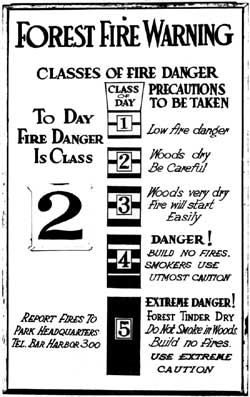|
DEFENSE SIGNALS!
BY FRED H. ARNOLD,
REGIONAL FORESTER.
"That fire burns is one of the first lessons of
childhood." Acquired later is a knowledge of fire behavior, as through
experience one observes that when it is dry and windy fires start more
easily and spread more rapidly. Add to these weather and fuel conditions
the factor of risk - presence or absence of an igniting agency - and you
have the substance of what is meant by fire danger.
When it has not rained for two or three weeks, with
little moisture in the air and perhaps a warm dry wind blowing, burning
conditions in fields and woods react accordingly and become
correspondingly dry. These conditions are plainly evident when dead
leaves in the forest crackle with brittle sounds underfoot and field
grasses swish and rustle against passing feet. Then it may be said the
fire danger is high in locations where, due to one cause or another,
fires are likely to flare up unexpectedly.
How dry is "high fire danger" and how much more
severe is "very high" or "extremely high fire danger? Does an individual
estimate the degree of fire danger consistently on the same basis on
different days? And does the term "high fire danger" convey the same
meaning to one person as to another? Unfortunately the use of
comparative adjectives is too indefinite and too subject to varying
individual interpretation to express definite degrees of a condition
such as fire danger. To appraise and rate fire danger accurately and on
an absolute rather than on a relative basis is a problem which has now
been solved successfully by the United States Forest Service through the
work of several of its Forest Experiment Stations.

(click image for an enlargement in a new window)
|
The basic system that has been developed is now in
use throughout the country in national and state forests and parks and
in other types of areas in public and private ownership. Briefly it
consists of measuring those few weather and fuel conditions which
substantially influence fire danger. These measurements are correlated
in a slide-rule type of scale known as a Fire Danger Meter. The
integrated result obtained from this meter is a simple number from 1 to
5, or to 6 to 7 in classifications used in some parts of the country.
Fire Danger Class 1 means low or nonexistent fire danger. Fire Danger
Class 5, 6, or 7, depending up on the classification in use, represents
an extremely high degree of danger.
The mere knowledge of the class of fire danger will
not of course prevent or put out fires. This reliable and definite
knowledge is only as good as it is effectively applied to the specific
problem of protecting an area against fire. For instance, good use is
made of the information when the fire fighting organization is stepped
up or reduced in accordance with the fluctuations in the readings. Fire
lookout stations can be manned or left unattended as the danger
conditions prescribe. Forests may be closed entirely to public use when
the highest class of fire danger is reached, and in parks certain forms
of use such as fishing, or habits such as smoking except in designated
places may be prohibited. Debris burning and other work activities which
may increase fire risk are ordinarily stopped while the high numbers are
recorded.
On the premise that increased cooperation from park
visitors in the matter of fire prevention is cultivated by informing
them of current fire danger conditions various devices have been made
and used to present the facts in an impressionable and understandable
manner. Acadia National Park's answer is the Forest Fire Warning board
pictured on page 16. This board indicates the fire danger class for the
day, explains briefly what each of the 5 classes means, and prescribes
the corresponding fire prevention precautions that should be observed.
Posted in public camp grounds, picnic areas and at other points where
people are most likely to see them, it has been observed that these
boards arouse curiosity. and lead people to explore their meaning.
Displayed in this manner, the boards frequently prompt questions above
fire protection in the park and stimulate fire consciousness on the part
of visitors and employees alike. If devices of this sort can provoke in
the minds of those who observe them a stronger realization of the need
for exercising greater care with fire they must be considered as
effective forest fire prevention media. The board shown here has
demonstrated its value in this respect at Acadia National Park.
|
Tobacco and matches discarded while burning and camp
fires built in unsafe locations or left unextinguished, cause a third of
all forest fires in the National Park System. PLEASE HELP US PROTECT
YOUR PARKS * * Be sure your fire is out! If you discover a fire report
it at once to a Ranger. (text quoted from National Park
Service sticker placed on menus in all national park hotels and
restaurants)
|
Acadia's Fire Invasion Threat is Posted Daily
| 
